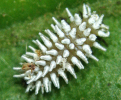Scientific name
Scymnus (Pullus) latemaculatus Motschulsky (=Scymnus quadrillum auctt.)
Taxonomic position
Coleoptera: Coccinellidae: Scymninae: Scymnini
Diagnosis
Length 1.6-2.0 mm, width 1.3-1.5 mm. Form short oval, moderately convex. Head yellowish, slightly darker towards apex in female. Pronotum dark brown or black, sides and anterior margin paler,
reddish brown. Scutellum black. Elytra dark brown/black, with two pairs of orange yellow spots, anterior pair large, transverse and subquadrate, posterior pair slightly smaller. Antenna (Fig. 1a) 11-segmented. Postcoxal line (Fig. 1b) complete, area enclosed sparsely punctate in middle, smooth along postcoxal line. Prosternal carinae (Fig. 1c) parallel, anteriorly convergent. Male genitalia diagnostic (Fig. 1d-e).
 Figs. 1a-e. Scymnus atemaculatus: a. Antenna; b. Postcoxal plate on abdominal sternite 1; c. Prosternal intercoxal process; d-e. Male genitalia: d. Sipho; e. Tegmen, ventral view Figs. 1a-e. Scymnus atemaculatus: a. Antenna; b. Postcoxal plate on abdominal sternite 1; c. Prosternal intercoxal process; d-e. Male genitalia: d. Sipho; e. Tegmen, ventral view Larva light brown with three pairs of conical, shiny white waxy extrusions (one dorsal, one dorsolateral and one lateral in position) on each segment of thorax and abdomen (except mesothoracic segment, which has only two pairs), short in early instars and longer in full-grown larvae. This species is very similar to the species of Horniolus in external appearance. Records of Horniolus guimeti (Mulsant) from South India are probably misidentifications of this species. Images



 Adult - dorsal habitus Adult - dorsal habitus

 Larva - dorsal view Larva - dorsal view
Distribution
Widely distributed almost throughout India (Andhra Pradesh; Assam; Karnataka; Kerala; Tamil Nadu; Uttar Pradesh). Myanmar. Taiwan. China.
Prey / Associated habitat
HEMIPTERA: Aphididae: Aphis craccivora Koch, Aphis gossypii Glover, Aphis laburni auct., Aphis nerii Boyer de Fonscolombe, Aphis punicae Passerini,
Aphis rumicis Linnaeus, Aphis spiraecola Patch, Myzus persicae (Sulzer), Pentalonia
nigronervosa Coquerel, Rhopalosiphum maidis (Fitch). Coccoidea: Aonidiella aurantii (Maskell), Aonidiella orientalis (Newstead), Coccidohystrix insolita (Green). Commonly associated with aphids feeding on crops such as cowpea, brinjal, cotton, bhendi, lablab, hibiscus, gliricidia, tobacco, and pigeonpea.
Seasonal occurrence
Collected almost round the year in and around Bangalore. Particularly active during July-October (Puttarudriah & Channabasavanna, 1953). Collected during March, and September-November in
northeastern region.
Natural enemies
Homalotylus terminalis (Say), H. t. californicus Girault, Homalotylus
sp. (Encyrtidae) and Pachyneuron sp. (Pteromalidae).
References
- Chelliah, S. 1965. The male genitalia of a few predaceous coccinellids (Coleoptera: Coccinellidae) of South India. Indian Journal of Entomology, 27, 165-167.
- Kapur, A.P. 1942. Bionomics of some Coccinellidae predaceous on aphids and coccids in north India. Indian Journal of Entomology, 4: 49-66.
- Pang, X. & Gordon, R.D. 1986. The Scymnini (Coleoptera: Coccinellidae) of China. The Coleopterists Bulletin, 40: 157-199.
- Puttarudriah, M. & Channabasavanna, G.P. 1953. Beneficial coccinellids of Mysore-I. Indian Journal of Entomology, 15: 87-96.
- Puttarudriah, M. & Channabasavanna, G.P. 1956. Some beneficial coccinellids of Mysore. Journal of the Bombay Natural History Society, 54: 156-159.
- Yang, C.T. 1978. Scymnus (subgenus Pullus) (Coleoptera: Coccinellidae) from Taiwan. Plant Protection Bulletin (Taiwan), 20(2): 106-116.
|